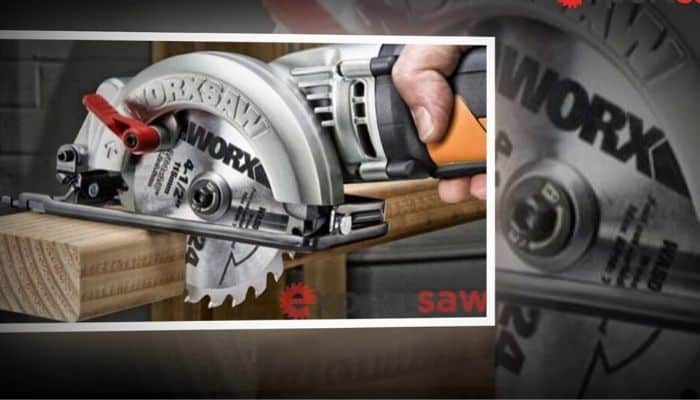Last Updated on March 26, 2024 by Sharaj
No matter you are using a circular saw or even a table saw, you can’t get the precision without the right set of blades. Well then, what do we mean by the right blade here?
Something that can fit your power tool and works efficiently on the material to give you the desired results. But, how will you find such an edge?
As you know there are no shortage of options and the number of available variants can even confuse one of the experienced woodworkers.
In this post we’re going to explain circular saw blade types and all the basic information that will help you to select the right blade for your next woodwork project.
Circular Saw Blade Types
We will start with the types of blade available for your power tools. It’s the most important decision because the blade type will decide what will be the cutting results.
Crosscut Blades: Suitable for cutting across the wooden blocks, a crosscut blade has teeth anywhere between 60 to 80. There are smaller gullets in between these teeth, hence such a blade gives you a precise and clean cut.
A crosscut blade has a chisel shape on top of all the teeth. Made of carbide steel, these chisels are set to the adjacent ones in opposite directions. It’s the reason these blades cut in a very fine manner.
Do you know that it’s harder to cut a wooden piece across its face? Due to the same reason, crosscut blades have large numbers of small teeth. You can use a crosscut blade with radial arm and table saws (read reviews). Keep in mind that mitre saws only use crosscut blades.
Rip-cut Blades: Perfect for making cuts along the length of a wooden piece, rip-cut blades has comparatively less number of blades that can vary between 16 to 40. Due to deep gullets, such a blade is efficient in chip removal and gives you smooth cuts.
Rip-cut blades are quick and efficient. So, when you are on a ripping spree using a radial arm or table saw, you know what blade you need to use. However, you cannot use these blades on a mitre saw because as stated earlier, it will only work with a crosscut module.
Combination Blades: Made for crosscut and ripping, crosscut blades have multiple groups of teeth divided by deep gullets. Every group has five teeth; one for rip apart the wooden piece and four for crosscutting.
So, if you don’t want to change the blades frequently according to the required cuttings, then it’s the right module to choose from. Use a combination blade with a radial arm or table saw and take benefits of crosscut as well as rip cuts.
General-purpose blades: Serves like a combination blade, but the design is different. Do not get confused between combination and general purpose blades, because both of these types work in the same pattern.
They can crosscut as well as rip apart a wooden log. However, you can differentiate them due to their design. In a general-purpose blade, all the teeth are of the same shape and size but are little bigger than those available on combination blades.
Materials You Need To Cut
What materials you will cut using the blade?
If you are cutting a wide range of materials using the same blade, then it will affect your choice. On the other hand, if you are only cutting a similar type of wood, then you can simply purchase the blade that’s specialized to cut the same.
For example, if you are cutting chipboard or plywood, then you can try the Freud LM72R010. It’s a 10-inch rip-cut blade applicable to both the materials. Means, it has the tooth count and size appropriate to cut these wooden materials.
We are not saying that a general-purpose blade will not be able to cut plywood or chipboard like a rip-cut or crosscut blade. But, if you are working on such items frequently, then why don’t you invest in something that specializes in cutting them?
Compatibility With The Power Tool
A minute back we were discussing that mitre saws only accept a crosscut blade. Similarly, some of the blades are only compatible with particular power tools. Using the wrong blade with an incompatible tool will result in poor cuttings.
If the blade and machine are not recognizing each other then they can express their frustration by raising safety concerns and even physical injuries. So, make sure you are getting a blade or set of blades according to your existing power tool.
- How will make sure that a blade is suitable for your power tool? Well, it’s generally clearly mentioned in the description. You can also determine the compatibility depending upon its size because each saw itself describes the maximum size of the blade it can utilize.
- Handheld circular saws can accept blades anywhere between 4 1/2 inches to 7 1/4 inches. Most of the circular saw blades come carbide tipped, which is also a recognizing sign. Check the best mini user friendly circular saw list this year.
- Table, radial –arm, and compound mitre saws utilize 10 and 12 inches’ blades. Such blades are also carbide tipped. You will also find 8 inches blades compatible with all these power tools, but such blades are not suitable for woodworking projects. If you are a craftsman or hobbyist, then you can use an 8” blade to complete small wooden projects.
- Tile cutting saw generally recognizes 7 or 10-inch diamond blades.
- Abrasive saws or metal cutting saws generally accepts 14-inch aluminium oxide abrasive or silicon carbide blades
Available Number Of Teeth
Remember the rule; a large number of teeth means a blade will provide smooth results while a module with fewer teeth will finish the cuttings faster. Generally, rip-cut blades have the lowest number of teeth when compared to crosscuts, combination and general-purpose blades.
For example, a rip cut blade like Freud LM72R010 comes with 24 blades, but a combination blade-like Dewalt DW3106P5 is built with 60 teeth.
The number of teeth on a combination blade can go up to 80. Both options are available with a diameter of 10 inches. Talking about 12-inch blades, the number of teeth can go up to 96.
Thin or Full Kerf
The width of slots that a blade makes on any of the wooden materials is called a kerf. It’s another important consideration because there are two types of kerfs available to purchase; thin and full. Thin kerf blades cut with a thickness of 3/32 inch, but full kerf blades have a cutting width of 1/8 inches. Some of the blades are available in both the kerf sizes.
Thin kerf blades are suitable for portable cutting tools that have a power of less than 3 HP. As thin kerf blades need to remove fewer materials while cutting, they require less power to operate and make no risk of extra friction resulting in distorted or burnt cuts.
You might think that a thin blade can vibrate more than thicker plates. But, advancement in technology as well as blade design compensate for the stability loss via vibration-dampening systems and make thinner blades perfect for low powered cutting machines.
Build Quality Of The Blades
You might not find much difference between the blades when you look at them casually. However, there are significant changes between the build quality that varies according to the make, model, and price.
Cheap quality blades are generally made of stainless steel. You might find carbide tips, but they are very small and you cannot sharpen them. Apart from that, their design does not resist vibrations and hence you don’t get smooth cutting results.
On the other hand, high-quality modules are made of carbide steel. Such an edge comes with anti-vibration slots for a smooth workshop experience. Apart from that, their cutting tips are pure carbide for efficient results. Due to their significant size, you can sharpen the tips for long. Such a blade also has slots cut into the structure to reduce any expansion due to heat generation while cutting.
Check The Blade Condition
Getting high-quality cuts does not only depend upon choosing the right and compatible blade for your power tool. You should also test the module before every sawing session to make sure that it is working as per the instructions. The simplest way to check a module is by cutting a scrap piece of wood.
When you use a blade regularly, it tends to lose its sharpness and also crack over time. Such a blade will not give you the desired results and can also result in kickbacks because it will not pass through the wooden piece cleanly. If you notice the pitch accumulated on the carbide tips, you should remove them before using a blade. If the edges are exhausted, then you should sharpen them before using any of those with a cutting machine.
Purchase a high-quality blade and you can sharpen it many a time. As we discussed earlier, you should always invest in a robust module that can result in smooth, quiet, quick cuts and retain its sharpness for a long time. for a long time.

